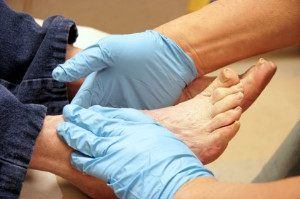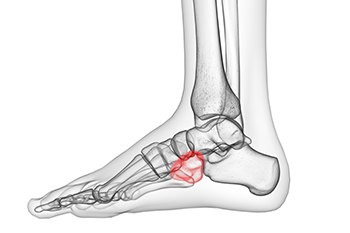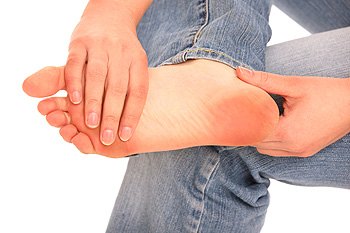Items filtered by date: May 2022
Diabetic Patients and the Inability to Feel Cuts on Their Feet

It is crucial for diabetic patients to check and manage their glucose levels daily, despite the time it can take from completing daily activities. The feet can typically be at risk in people who have diabetes, and this can be a result of the inability to feel sensations related to the feet. It is important to look for existing cuts, bruises, or scrapes. Some patients prefer to use a mirror to look at the sole of the foot. Diabetic foot care begins with washing and drying the feet daily, followed by using a good moisturizer on the entire foot except for the toes. It is common for diabetic patients to have poor circulation, and this can make it difficult for sores on the foot to heal. Foot ulcers are cuts or wounds on the feet that have become infected, and must be treated immediately to avoid possible gangrene. If you are diabetic, it is strongly suggested that you are under the care of a podiatrist who properly treats and offers helpful management tips.
Diabetic foot care is important in preventing foot ailments such as ulcers. If you are suffering from diabetes or have any other concerns about your feet, contact one of our podiatrists from Advanced Ankle & Foot Surgeons. Our doctors can provide the care you need to keep you pain-free and on your feet.
Diabetic Foot Care
Diabetes affects millions of people every year. The condition can damage blood vessels in many parts of the body, especially the feet. Because of this, taking care of your feet is essential if you have diabetes, and having a podiatrist help monitor your foot health is highly recommended.
The Importance of Caring for Your Feet
- Routinely inspect your feet for bruises or sores.
- Wear socks that fit your feet comfortably.
- Wear comfortable shoes that provide adequate support.
Patients with diabetes should have their doctor monitor their blood levels, as blood sugar levels play such a huge role in diabetic care. Monitoring these levels on a regular basis is highly advised.
It is always best to inform your healthcare professional of any concerns you may have regarding your feet, especially for diabetic patients. Early treatment and routine foot examinations are keys to maintaining proper health, especially because severe complications can arise if proper treatment is not applied.
If you have any questions please feel free to contact our office located in O'Fallon, and New Baden, IL . We offer the newest diagnostic and treatment technologies for all your foot and ankle needs.
Podiatry Services for Neurodivergent Children

While autism is a neurological condition some neurodivergent children, particularly those who are autistic, may have problems with their legs and feet to a greater degree than their neurotypical peers. Autistic children may have low muscle tone or hypotonia which occurs when limbs are floppy and hard to move. Given that autistic children react to external stimuli with sensitivity, their feet may be sensitive to the shoes they wear too. Children with this condition can be uncomfortable with any type of movement including walking, running, and even standing. Some children grow out of this while others do not. Such issues increase autism symptoms and can make the child unhappy or irritable. Specialized footwear, specific exercises, and orthotic inserts might help improve children’s movement. It is suggested that autistic children have regular visits with a podiatrist to check for foot discomfort and help to manage their symptoms.
Making sure that your children maintain good foot health is very important as they grow. If you have any questions, contact one of our podiatrists of Advanced Ankle & Foot Surgeons. Our doctors can provide the care you need to keep you pain-free and on your feet.
Keeping Children's Feet Healthy
Having healthy feet during childhood can help prevent medical problems later in life, namely in the back and legs. As children grow, their feet require different types of care. Here are some things to consider...
Although babies do not walk yet, it is still very important to take care of their feet.
Avoid putting tight shoes or socks on his or her feet.
Allow the baby to stretch and kick his or her feet to feel comfortable.
As a toddler, kids are now on the move and begin to develop differently. At this age, toddlers are getting a feel for walking, so don’t be alarmed if your toddler is unsteady or ‘walks funny’.
As your child gets older, it is important to teach them how to take care of their feet.
Show them proper hygiene to prevent infections such as fungus.
Be watchful for any pain or injury.
Have all injuries checked by a doctor as soon as possible.
Comfortable, protective shoes should always be worn, especially at play.
If you have any questions please feel free to contact our office located in O'Fallon, and New Baden, IL . We offer the newest diagnostic and treatment technologies for all your foot and ankle needs.
Treatment of Cuboid Syndrome

Cuboid syndrome, or cuboid subluxation, happens when the joint and ligaments near the cuboid bone in the foot are injured or torn. Generally, this comes from an ankle sprain or fracture, where the cuboid bone moves out and the heel bone moves in and one or both bones are dislocated, or nearby ligaments are torn. Those who play sports, engage in activities where repetitive strain is put on the foot, or have flat feet, arthritis, or a bone condition, are more apt to suffer from cuboid syndrome. Being overweight, wearing shoes that are too tight or not supportive, not stretching the foot properly before working out, or not resting the foot after physical activity are also high risk factors for this condition. The most typical symptom of cuboid syndrome is pain on the outside of the foot where the smallest toe is. This pain can spread to other parts of the foot when standing as well. Other symptoms might include redness and swelling near the injury site, loss of mobility in the ankle or the outside of the foot, weakness in the outside toes, and a change in walking due to pain avoidance. If symptoms persist, or if another major injury has been sustained, a podiatrist should be seen for proper diagnosis and treatment.
Cuboid syndrome, also known as cuboid subluxation, occurs when the joints and ligaments near the cuboid bone in the foot become torn. If you have cuboid syndrome, consult with one of our podiatrists from Advanced Ankle & Foot Surgeons. Our doctors will assess your condition and provide you with quality foot and ankle treatment.
Cuboid syndrome is a common cause of lateral foot pain, which is pain on the outside of the foot. The condition may happen suddenly due to an ankle sprain, or it may develop slowly overtime from repetitive tension through the bone and surrounding structures.
Causes
The most common causes of cuboid syndrome include:
- Injury – The most common cause of this ailment is an ankle sprain.
- Repetitive Strain – Tension placed through the peroneus longus muscle from repetitive activities such as jumping and running may cause excessive traction on the bone causing it to sublux.
- Altered Foot Biomechanics – Most people suffering from cuboid subluxation have flat feet.
Symptoms
A common symptom of cuboid syndrome is pain along the outside of the foot which can be felt in the ankle and toes. This pain may create walking difficulties and may cause those with the condition to walk with a limp.
Diagnosis
Diagnosis of cuboid syndrome is often difficult, and it is often misdiagnosed. X-rays, MRIs and CT scans often fail to properly show the cuboid subluxation. Although there isn’t a specific test used to diagnose cuboid syndrome, your podiatrist will usually check if pain is felt while pressing firmly on the cuboid bone of your foot.
Treatment
Just as the range of causes varies widely, so do treatments. Some more common treatments are ice therapy, rest, exercise, taping, and orthotics.
If you have any questions, please feel free to contact our office located in O'Fallon, and New Baden, IL . We offer the newest diagnostic and treatment technologies for all your foot care needs.
It's Time for Beautiful Feet
How Lupus Can Affect the Feet

A person with lupus might experience swelling in the feet and ankles because the inflammation of lupus attacks the kidneys, which can lead to fluid build-up or edema of the lower extremities. Swelling can make movement uncomfortable, lead to pain, and become more serious if left untreated. Reducing sodium in the diet and controlling high blood pressure can help with swelling. It is also wise to discuss medicines that can ease pain with a podiatrist. A podiatrist can provide valuable education on how Lupus affects the feet and assist in devising a customized treatment plan to control symptoms.
When dealing with systemic disease of the feet, it is extremely important to check the affected areas routinely so that any additional problems are caught quickly. If you have any concerns about your feet and ankles contact one of our podiatrists from Advanced Ankle & Foot Surgeons. Our doctors will assist you with all of your podiatric needs.
Systemic Diseases of the Feet
Systemic diseases affect the whole body, and symptoms usually are displayed in the feet. This condition can make a patient’s ability to walk unbearable. Systemic diseases include gout, diabetes mellitus, neurological disorders, and arthritis.
Gout – is caused by an excess of uric acid in the body. Common symptoms include pain, inflammation, and redness at the metatarsal/phalangeal joint of the base big toe. Gout can be treated by NSAIDs to relieve pain and inflammation, and other drugs that lower the acid levels in the body.
Diabetes mellitus – is an increase in the level of blood sugar that the body cannot counteract with its own insulin. Failure to produce enough insulin is a factor in Diabetes.
Diabetes of the Feet
Diabetic Neuropathy – may lead to damaged nerves and affect the feet through numbness and loss of sensation.
Peripheral Vascular Disease – can restrict the blood flow to the feet, and often times lead to amputation of the feet.
If you have any questions please feel free to contact our office located in O'Fallon, and New Baden, IL . We offer the newest diagnostic and treatment technologies for all your foot and ankle needs.
Grading the Severity of a Sprained Ankle

Ankle sprains are injuries that affect many people, regardless of how active or inactive they may be. Ankle sprains occur when one or more of the strong ligaments that support and bind the ankle become stretched beyond their normal bounds, or even torn in severe cases. This injury causes varying degrees of pain, swelling, and mobility issues which are graded by severity. Grade 1 ankle sprains cause mild pain and swelling, and there is no visible bruising, joint instability, or difficulty bearing weight. Ligaments are minimally stretched, so recovery time generally falls within one to three weeks. With a grade 2 ankle sprain the pain, swelling, and tenderness can range from mild to moderate. There may be some joint instability and bruising. Bearing weight may be painful, and it may be difficult to move the ankle. The recovery time typically doubles, because the ligament has been partially torn. A grade 3 ankle sprain is the most severe because the ligament(s) have torn fully or ruptured. This causes severe pain, swelling, bruising, and tenderness. It is impossible to walk due to the ankle being considerably unstable and unable to bear weight. Also, a grade 3 ankle sprain can take several months to fully heal. If you believe you have sprained your ankle, make an appointment with a podiatrist as soon as possible.
Ankle sprains are common but need immediate attention. If you need your feet checked, contact one of our podiatrists from Advanced Ankle & Foot Surgeons. Our doctors can provide the care you need to keep you pain-free and on your feet.
How Does an Ankle Sprain Occur?
Ankle sprains take place when the ligaments in your ankle are torn or stretched beyond their limits. There are multiple ways that the ankle can become injured, including twisting or rolling over onto your ankle, putting undue stress on it, or causing trauma to the ankle itself.
What Are the Symptoms?
- Mild to moderate bruising
- Limited mobility
- Swelling
- Discoloration of the skin (depending on severity)
Preventing a Sprain
- Wearing appropriate shoes for the occasion
- Stretching before exercises and sports
- Knowing your limits
Treatment of a Sprain
Treatment of a sprain depends on the severity. Many times, people are told to rest and remain off their feet completely, while others are given an air cast. If the sprain is very severe, surgery may be required.
If you have suffered an ankle sprain previously, you may want to consider additional support such as a brace and regular exercises to strengthen the ankle.
If you have any questions please feel free to contact our office located in O'Fallon, and New Baden, IL . We offer the newest diagnostic and treatment technologies for all your foot and ankle needs.

